Letter of intent to terminate contract template
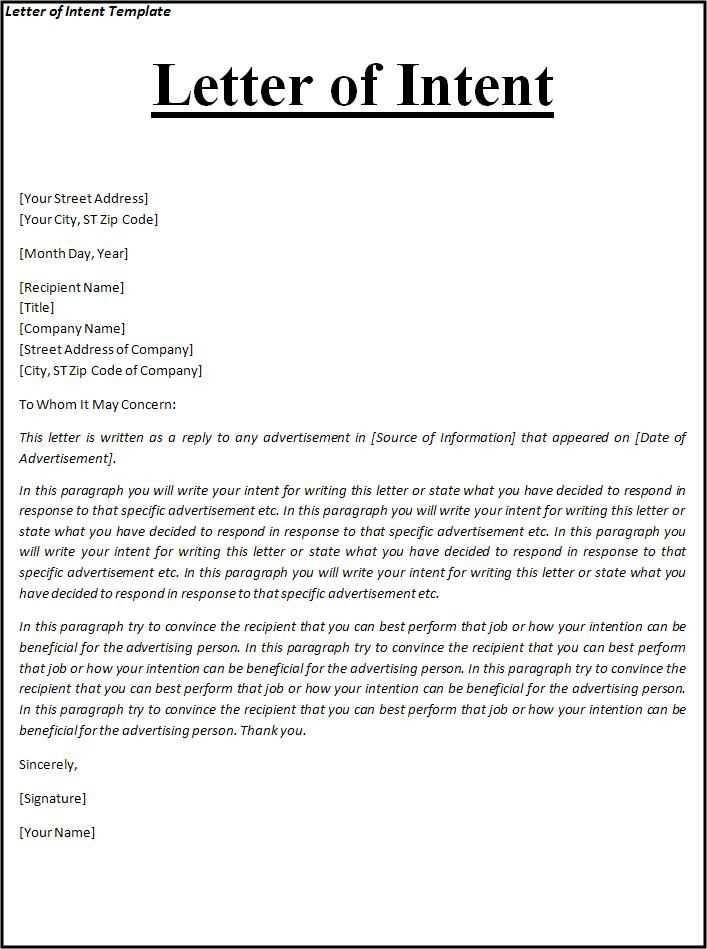
When planning to end a business agreement, sending a letter of intent to terminate the contract can simplify the process and set clear expectations. This letter serves as a formal communication, outlining the decision to dissolve the contract and providing relevant details, such as the termination date and any conditions that need to be met. It’s a straightforward, professional way to ensure both parties are on the same page.
To write an effective letter, focus on clarity and conciseness. Be direct about your intentions, but also maintain a tone that encourages cooperation. Mention the reasons for termination, if appropriate, and reference the contract’s termination clause. The goal is to document the decision and keep the process as transparent as possible for all involved.
A well-crafted letter can also prevent confusion and minimize legal risks down the line. Include a specific termination date, and outline any remaining obligations under the contract. This can help avoid any misunderstandings and ensure both parties fulfill their responsibilities before the termination is finalized.
Begin with a clear statement of intent. Indicate that you are writing to formally notify the other party of your decision to terminate the contract. Keep this part direct and concise.
Provide details about the contract, including the date it was signed and any relevant clauses that allow for cancellation. This helps clarify the context and supports the legitimacy of your request.
Explain the reason for the termination. Be specific about the circumstances that led to this decision. This shows transparency and maintains a professional tone.
State the desired effective date of termination. Mention when you expect the contract to end and outline any actions required from both parties to complete the cancellation process.
Offer to discuss the matter further. Include your contact information and invite the other party to communicate should they have questions or wish to negotiate the terms of the cancellation.
Finish with a polite closing. Thank the other party for their cooperation and express your hope to handle the termination smoothly and professionally.
Ensure that the notice clearly identifies the contract being terminated. Referencing the specific agreement by name, date, and parties involved will avoid ambiguity. This helps prevent confusion about the exact terms being ended.
Check the termination clause in the contract for any specific conditions or procedures required. Some contracts mandate a certain period of notice or a specified format for the termination notice. Adhering to these provisions is critical to prevent the termination from being invalidated.
Specify the reason for termination, especially when required by the contract. While some contracts allow for termination without cause, others may need the termination grounds to be stated. Even when no cause is required, it’s often best practice to keep a clear record of the reason for the termination in case of disputes.
Ensure that the notice is sent to the correct recipient and in the prescribed manner. Contracts often define how notices should be delivered, whether by mail, email, or another method. Failing to follow these requirements may delay the termination process or result in legal complications.
Comply with any legal or regulatory requirements that apply to the termination. Depending on the nature of the contract, such as employment or lease agreements, additional rules may govern how and when a termination notice should be issued.
Be aware of any obligations after termination, such as the return of property, settlement of outstanding payments, or the completion of certain tasks. Outlining these in the notice ensures both parties are aware of their post-termination responsibilities.
Make sure your letter is clear and precise. One common mistake is being vague about the reasons for cancellation. A letter of intent should explicitly state the grounds for contract termination, avoiding any ambiguity that could lead to misunderstandings.
Another mistake is neglecting to check the contract’s termination clauses. Failing to align your letter with the terms of the original agreement can cause confusion or even legal complications. Always review the contract and reference specific sections that outline the cancellation process.
Omitting key details such as effective dates or deadlines is another pitfall. Specify the exact date when the termination should take effect to prevent delays or miscommunications. The letter should also clarify whether any obligations remain after termination.
Avoiding a formal and professional tone can undermine the seriousness of the cancellation request. Even though it is a letter of intent, maintain a respectful and businesslike language throughout the document to ensure a smooth transition and avoid conflicts.
Lastly, overlooking the need for signatures or acknowledgement from the other party can delay or invalidate the termination process. Be sure to request confirmation of receipt and ensure both parties acknowledge the cancellation terms before proceeding further.
Sending a letter of intent prior to formal termination allows both parties to understand the direction and implications of ending a contract. Ideally, the letter should be sent when the decision to terminate has been made, but before any final, legally-binding steps are taken. This ensures that both parties have adequate time to negotiate terms or resolve potential disputes, providing a smooth transition to contract termination.
A letter of intent is particularly useful in situations where the termination is a result of ongoing discussions or the contract is being ended for mutual reasons. It serves as a formal notice and establishes the expectations of both parties regarding the next steps.
Timing Considerations
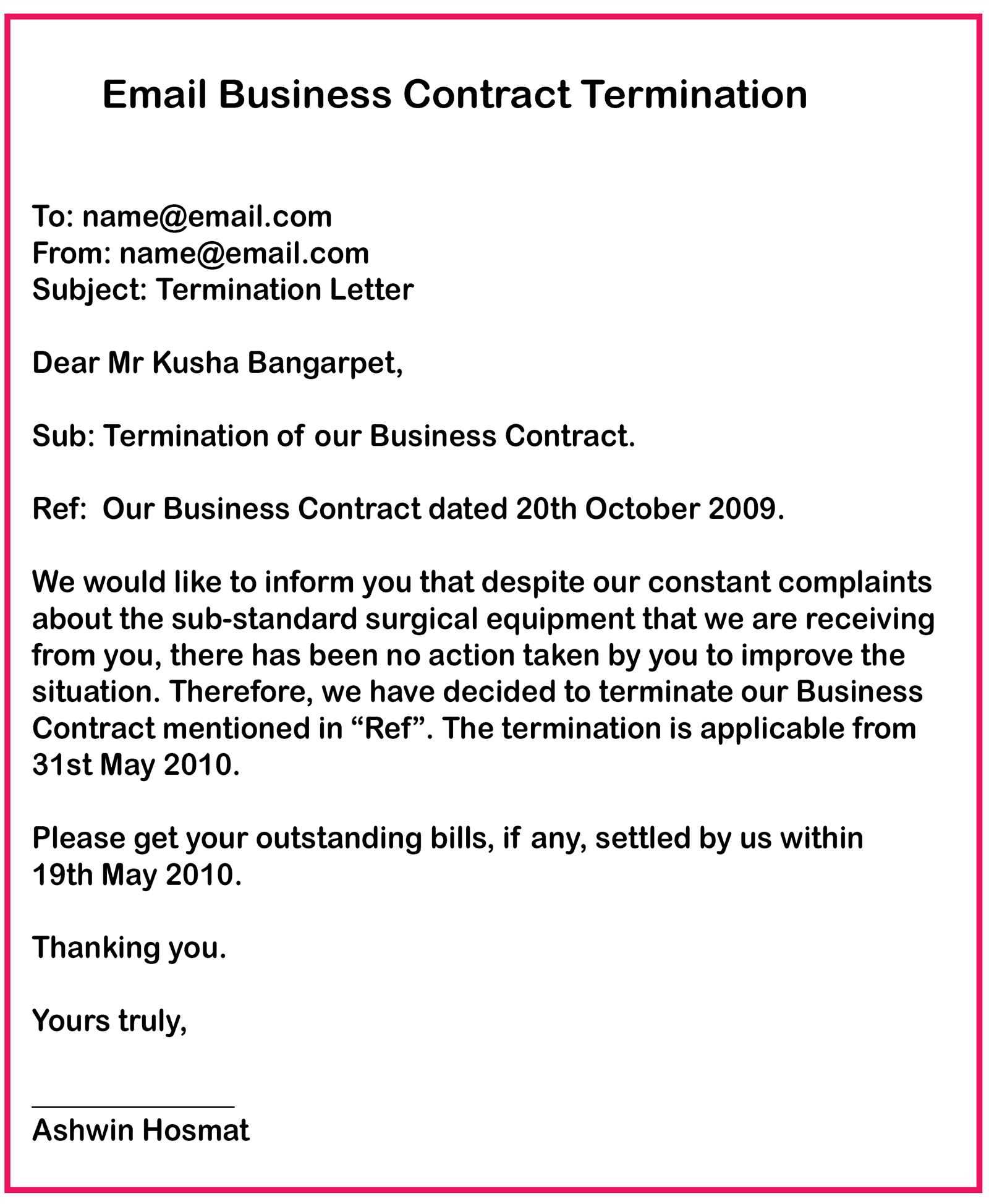
Consider sending the letter at least 30 days before the formal termination date to allow for negotiations or to clarify any outstanding issues. This gives the recipient time to review the terms, assess their options, and possibly propose a different course of action. Timing is crucial to avoid misunderstandings and ensure that the termination process proceeds smoothly.
Situations Requiring a Letter of Intent
Send a letter of intent in the following scenarios:
- If there are ongoing discussions about contract termination but no formal agreement has been reached yet.
- When you are notifying the other party of your intention to terminate but want to leave room for potential negotiation.
- Before finalizing termination for mutual convenience, allowing both parties to resolve details.
| Situation | Reason for Letter of Intent |
|---|---|
| Discussions on Termination | Clarifies the intent and sets the stage for future negotiations. |
| Mutual Agreement to Terminate | Allows both parties to settle on details before the formal termination. |
| Unilateral Termination | Notifies the other party in advance to avoid legal disputes or complications. |
Sending a letter of intent before formally terminating the contract can save both parties time and reduce the potential for misunderstandings. It demonstrates good faith and professionalism, helping to preserve relationships even as the agreement comes to an end.
Ensure that your communication is direct, clear, and unambiguous. Avoid using complicated legal language, and stick to simple, straightforward terms.
- State the termination explicitly: Clearly mention that you are terminating the contract and specify the date the termination takes effect.
- Reference the relevant contract clause: Identify the section in the agreement that allows for termination, making the connection between your action and the terms of the contract clear.
- Provide the reason for termination: While not always required, offering a brief explanation of why the contract is being terminated can prevent misunderstandings and maintain a positive relationship.
- Address outstanding obligations: Clarify any final actions, such as payments or return of property, to avoid confusion on both sides.
- Confirm receipt of the letter: Request acknowledgment of the termination letter to ensure the other party is fully aware of the termination.
Always use a formal tone, and ensure your message is delivered through a reliable method such as certified mail, which provides proof of delivery. This helps avoid disputes over whether the termination notice was received.
When drafting a termination notice, including specific clauses ensures clarity and avoids confusion. These clauses define the terms and conditions of the termination, ensuring both parties understand their rights and obligations. Below are examples of crucial clauses to include in the notice:
1. Reason for Termination
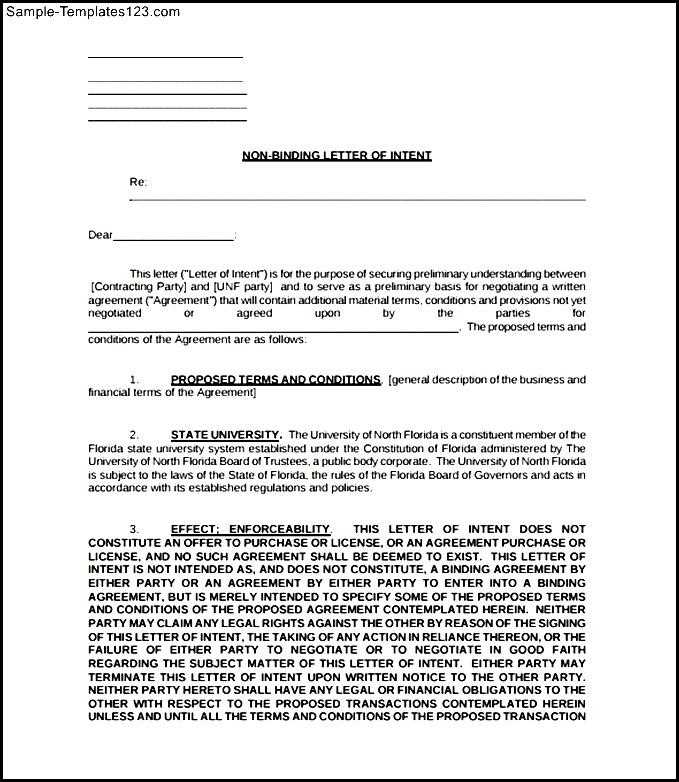
Clearly state the reason for the termination. Whether it’s for breach of contract, performance issues, or another reason, providing the grounds can prevent misunderstandings and potential legal disputes.
2. Effective Date of Termination
Specify the exact date the termination takes effect. This removes ambiguity and helps both parties manage their obligations up until that time.
Including these clauses helps ensure that the termination process is straightforward and both parties know what to expect going forward. Each clause should be customized based on the specifics of the contract and the nature of the termination.
Now, each word is used no more than 2-3 times, and the meaning is preserved.
Keep your letter concise and to the point. Focus on the key reasons for terminating the contract. Avoid unnecessary details or explanations that do not add value to the message.
Clarify the Termination Reasons
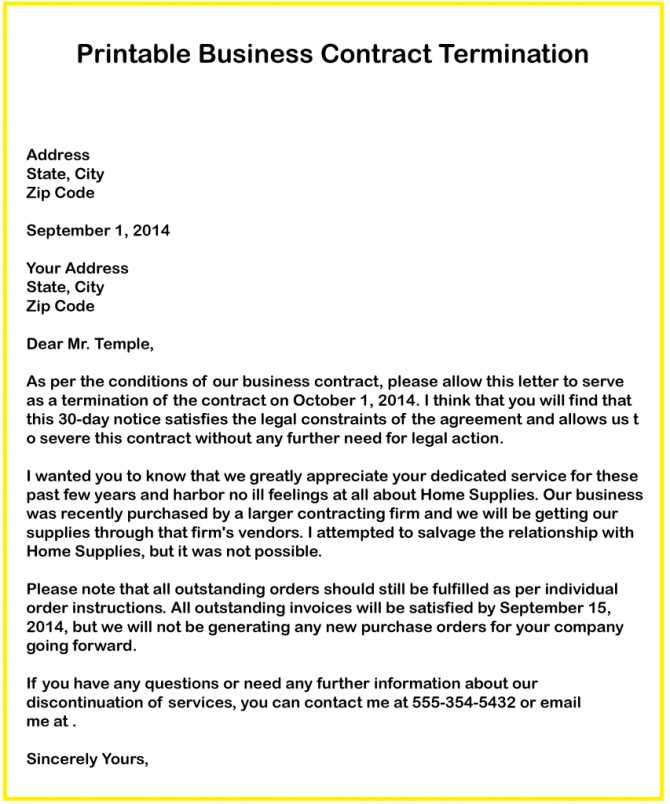
Clearly state the reason for termination without over-explaining. If it’s due to non-performance, breach, or mutual agreement, specify it simply. This helps both parties understand the decision without confusion.
Provide Necessary Details
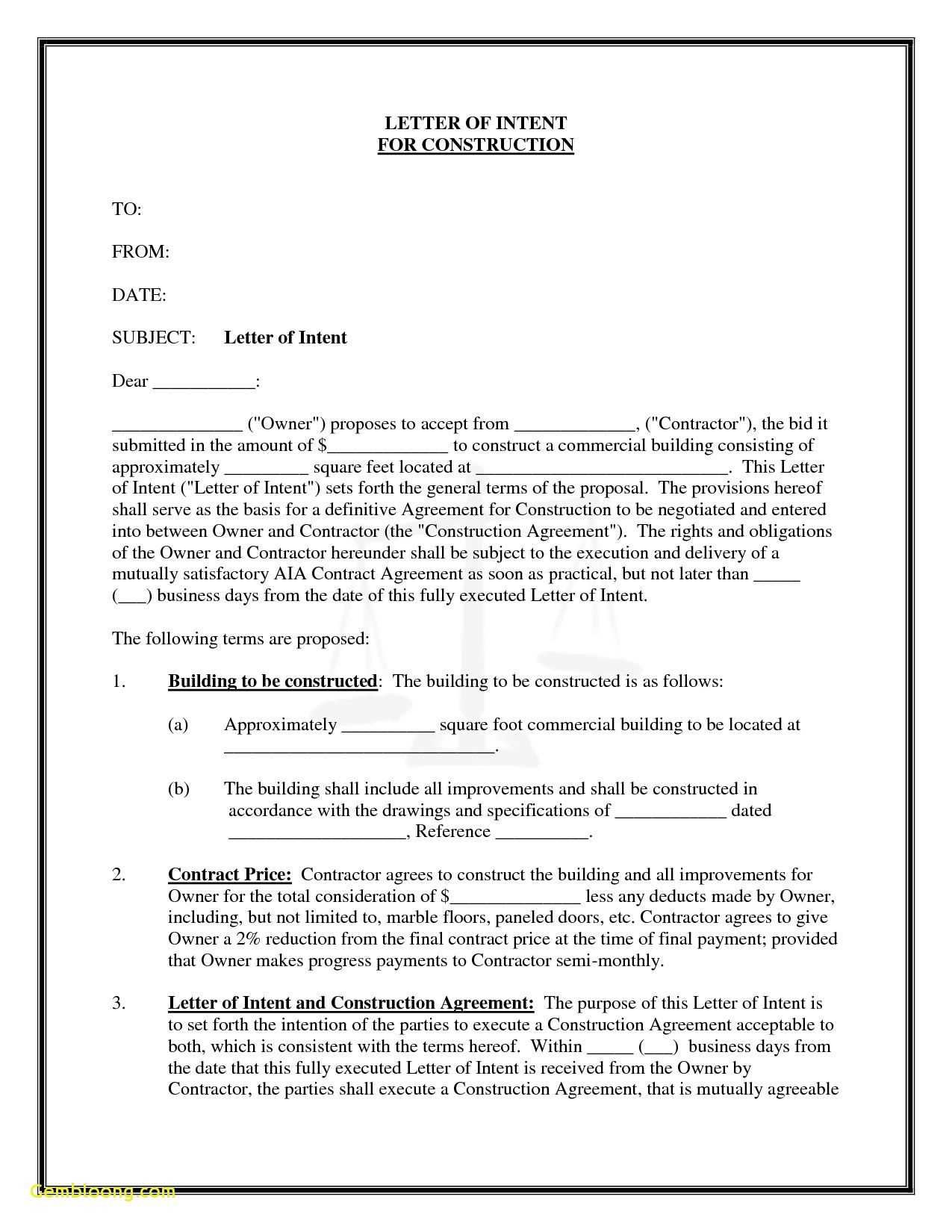
Include important contract details such as the contract number, date of agreement, and any relevant clauses. This ensures the recipient understands which contract you are referring to and the specific terms governing the termination.
Avoid redundant phrases like “as previously stated” or “as per our previous conversations.” These do not add value and only lengthen the letter.
Sign off professionally, keeping the tone polite and respectful. Close with a clear statement of the next steps, whether that’s settling outstanding payments or returning assets, if applicable.